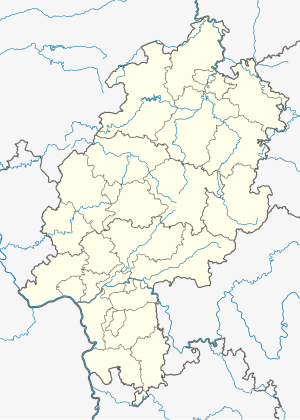Hönebach tunnel
| Hönebach tunnel | ||
|---|---|---|
|
Eastern portal
|
||
| Official name | Hönebach tunnel | |
| use | Railway tunnel | |
| traffic connection | Halle – Bebra railway line | |
| length | 983 m | |
| Number of tubes | 1 | |
| construction | ||
| Client | Friedrich-Wilhelms-Nordbahn-Gesellschaft | |
| start of building | 1845 | |
| completion | 1848 | |
| business | ||
| operator | DB Netz AG | |
| location | ||
|
|
||
| Coordinates | ||
| East portal | 50 ° 56 ′ 7 ″ N , 9 ° 56 ′ 8 ″ E | |
| West portal | 50 ° 56 ′ 16 " N , 9 ° 55 ′ 20" E | |
The Hönebach tunnel is a 983 m long double-track railway tunnel on the Halle – Bebra railway line ( route kilometers 199.345 to 200.328). It was created as part of the Friedrich-Wilhelms-Nordbahn ( Gerstungen - Bebra - Kassel ) by the Friedrich-Wilhelms-Nordbahn-Gesellschaft . They had the tunnel built between 1845 and 1849 by the Belgian company Goffard.
The tunnel is located between the Wildeck - Hönebach train station and the Ronshausen stop . It passes under a northern branch of the Seulingswald and the federal motorway 4 . The tunnel portals are designed the same at both ends - each with two identical towers. On the ridge above the tunnel, there are still two twelve-sided of the original four smoke extraction towers, which are shaped like chimneys. The tunnel is a cultural monument according to the Hessian Monument Protection Act .
In 1992, a shotcrete shell was installed in front of it. In the course of the electrification of the section between Neudietendorf and Bebra, which began in 1993 and was completed in 1995, special measures were required in the Hönebach tunnel. Since the existing profile should not be changed for economic reasons, conventional overhead contact line arms with insulators could not be installed. The suspension cables could not be installed along the entire length of the tunnel and were attached to the tunnel ceiling in the remaining sections. The tensioning devices were set up at the tunnel portals. The system height of the double contact wire catenary system is between 0.50 m and 0.85 m.
Due to the narrow profile and the associated aerodynamic conditions, the tunnel could only be driven at 120 km / h in the 1990s. Between 2000 and 2005 it was only approved for 90 km / h from the direction of Eisenach , while from the direction of Bebra it was still allowed to be driven at 120 km / h. Since a measurement run was evaluated in 2005, the maximum speed of the tunnel has been limited to 90 km / h on both sides. The reason given is that the tunnel clearance is too low .
In November 2014, the planning (initially basic assessment and preliminary planning ) for the renovation of the tunnel was tendered across Europe. The construction of a single-track tunnel with renewal of the existing one, a new double-track tunnel (<1000 m) and two new single-track tunnels (> 1000 m) are being considered. The design speed is 160 km / h. While the tunnel could have been driven at 160 km / h, the pre-cuts would only have allowed 120 or 140 km / h. In November 2017, the planning area of about 700 m was on the east side or to 1400 m on the west side of the tunnel extended hours to a continuous navigability of the section with 160 km / make a contribution for a part of the Germany-clock scheduled Target travel time between Erfurt and Fulda of 60 minutes. The 7-month contract is worth around 183,000 euros.
In September and October 2020, the tracks in the tunnel are to be renewed and the route between Faßdorf and Wildeck-Hönebach will be closed.
literature
- State Office for Monument Preservation Hessen (Ed.): Railway in Hessen. Cultural monuments in Hessen. Monument topography Federal Republic of Germany . tape 2.1 . Theiss Verlag, Stuttgart 2005, ISBN 3-8062-1917-6 , p. 138 .
Individual evidence
- ^ A b c d e Germany-Frankfurt am Main: Services from engineering offices . Document 2014 / S 216-382995 of November 8, 2014 in the supplement to the Electronic Official Journal of the European Union .
- ↑ a b Werner Gruner, Dietwalt Moschkau, Wolfgang Hubrich: Electrification of the Neudietendorf - Eisenach - Bebra line . In: Electric Railways . tape 93 , no. 9/10 , 1995, ISSN 0013-5437 , pp. 329-332 .
- ↑ KBS 605 (Bebra-Eisenach) in the route directory by Marcus Grahnert , KBS 605 (Eisenach-Bebra) in the route directory by Marcus Grahnert
- ^ Germany-Frankfurt am Main: Geotechnical services. In: ted.europa.eu. November 4, 2017. Retrieved November 4, 2017 .
- ↑ Nicole Knapp: Selection of important construction measures 2020 - Effects on rail traffic. (PDF) In: deutschebahn.com. Deutsche Bahn, January 29, 2020, p. 2 , accessed on February 5, 2020 .
Web links
- Location and course of the tunnel on the OpenRailwayMap
- Pictures of the tunnel portals and further information


